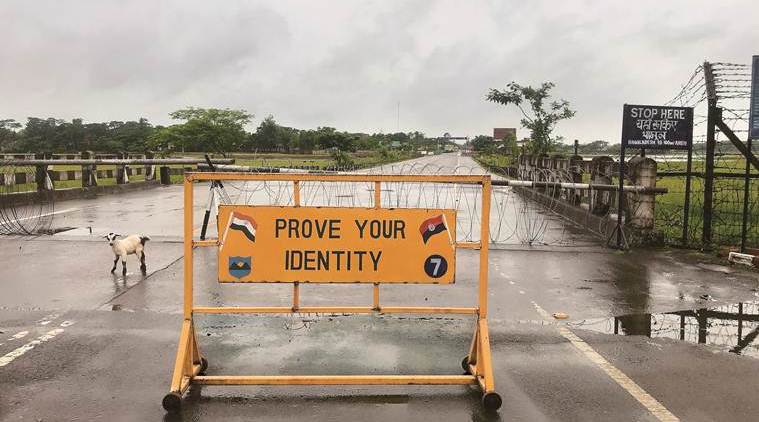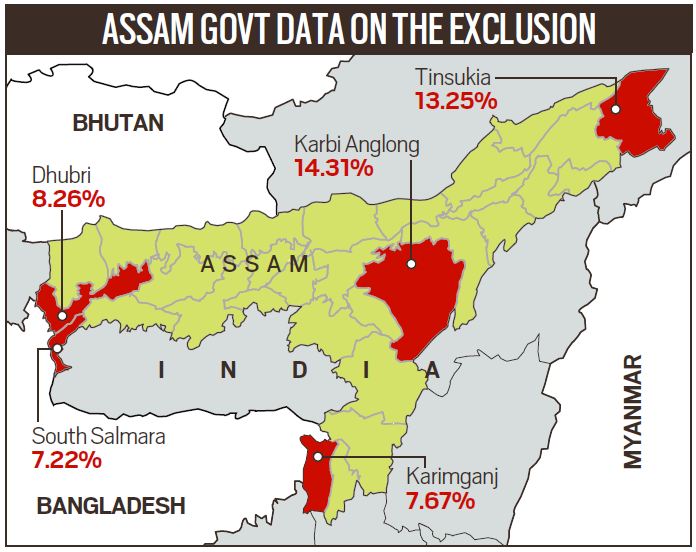Stay updated with the latest - Click here to follow us on Instagram
Flying in SC face, Assam releases list of how many out of NRC in each district
In districts close to the Bangladesh border — where the share of Muslims in the population is high — the exclusion percentage was lower, while in other districts it was comparatively higher.
 The government used this data to argue that the process was flawed and several BJP MLAs slammed the court-mandated coordinator Prateek Hajela. (File)
The government used this data to argue that the process was flawed and several BJP MLAs slammed the court-mandated coordinator Prateek Hajela. (File)
Flying in the face of the Supreme Court’s directions to the State NRC Coordinator almost a year ago, the Assam government Thursday revealed district-wise figures of people left out from the National Register of Citizens. And said that in districts close to the Bangladesh border — where the share of Muslims in the population is high — the exclusion percentage was lower, while in other districts it was comparatively higher.
The government used this data to argue that the process was flawed and several BJP MLAs slammed the court-mandated coordinator Prateek Hajela.
On August 16 last year, the Supreme Court had asked Hajela “to file in Court, in a sealed cover, the percentage of the population in each district (district-wise) who have been left out of the final draft NRC.”
Responding to a Zero Hour notice in the Assembly, Parliamentary Affairs Minister Chandra Mohan Patowary said in a written statement, “According to data, 12.15% applicants’ names were excluded from the final draft. In districts close to the Bangladesh border, like South Salmara, 7.22% applicants were excluded from the draft NRC. This figure in Dhubri is 8.26% and in Karimganj 7.67%. But districts where indigenous people live, like Karbi Anglong, the figure is 14.31% and in upper Assam’s Tinsukia, where sons of the soil have been living for ages, this figure is 13.25%.”
 The famed river island of Majuli had the lowest exclusion rate of 1.62% followed by that of the upper Assam district of Charaideo at 2.88%.
The famed river island of Majuli had the lowest exclusion rate of 1.62% followed by that of the upper Assam district of Charaideo at 2.88%.
The percentage of Muslim population in Dhubri was 79.67%, and in Karimganj was 56.36%, according to Census 2011. South Salmara was carved out of Dhubri in 2016.
Explained: Why district-wise figures of people excluded from NRC draft matters
The government highlighted that reports “suggested wrongful inclusions and exclusions in the NRC”. This was the reason the state demanded a 20% re-verification in districts closer to the Bangladesh border and 10% re-verification in others, it said.
After the Supreme Court insisted that the NRC be ready by the end of this month, the Assam government’s release of this data ratchets up political pressure for re-verification. The data that shows low exclusion in Muslim-dominated areas doesn’t fit with the BJP’s narrative. All eyes are on the court now.
The Supreme Court, however, had rejected the request by the state and the Centre to order a sample verification on July 23 this year. Hajela had said that in the course of consideration/ adjudication of the claims, the SNRC had already undertaken re-verification to the extent of 27%, the Court noted.
The overall data provided by the government in the Assembly places Hojai district at the top with an exclusion rate with 32.99%, followed by Darrang at 30.9% (Muslim population 64.34%, according to 2011 Census). Hojai was carved out of Nagaon in 2015, and apart from Muslims, it is home to large numbers of indigenous tribes and Bengali-speaking Hindus.
Explained | Why Supreme Court extended deadline to publish final NRC
The exclusion rate in Nagaon (Muslim population 55.36%) was 14.12%. Other Muslim-majority districts like Morigaon (52.56% Muslims) and Barpeta (70.74% Muslims) left out 15.04% and 13.4% of the population, respectively.
The famed river island of Majuli had the lowest exclusion rate of 1.62% followed by that of the upper Assam district of Charaideo at 2.88%.
When contacted, Patowary told The Indian Express, “We had presented the same data and arguments to the Supreme Court earlier but the court had not taken cognisance. When members of the Assembly were discussing the issue today during Zero Hour, I presented before the Assembly the data and the arguments. Areas close to the borders have registered high inclusion rates whereas certain areas where indigenous communities live have registered high exclusion.”
Read | Can India really deport illegal immigrants after the final NRC list
Citing the example of his colleague, BJP MLA Rama Kanta Dewri, from the Tiwa community, Patowary said, “He has been excluded from the NRC draft. We demand a re-verification because we want our NRC to be absolutely error-free.”
Three BJP MLAs, participating in the Zero Hour discussion, too, demanded re-verification and criticised Hajela for his comment that 27% re-verification had being already done. They raised questions regarding the supposed inclusion of allegedly illegal Bangladeshi citizens in the NRC.
“The entire process is left in the hands and mercy of one person who is the state coordinator of the NRC. Nobody is to be heard on it. The Home Ministry in Centre, the Chief Minister of the state – nobody.. On the one hand, the Centre and state government want at least 20% re-verification in the districts of Assam bordering Bangladesh but State Coordinator says he has already done 27%. This proves there is no coordination between the government and the NRC work, which is dangerous for our democracy,” said BJP MLA Shiladitya Dev.
Also Read | India moving: In the times of NRC, a look at where the migrants fit in
BJP MLAs Debananda Hazarika and Numal Momin questioned the re-verification claimed to have been already undertaken by Hajela and reiterated the issues raised by the government in its response during Zero Hour notice.
“In areas close to international border, 5-6% names were not included. Whereas, areas, where indigenous people including tribals reside up to 18% names, have not been included. People started questioning NRC itself. NRC has to be correct, with 0% error. No foreigner’s name can be included,” said Momin.
Hazarika questioned whether the NRC would be a correct one, “free from any single foreigner”. “If correct, then it will be a Magna Carta or else it will be a threat to stability, sovereignty, national integrity and unity of our country,” he said.






